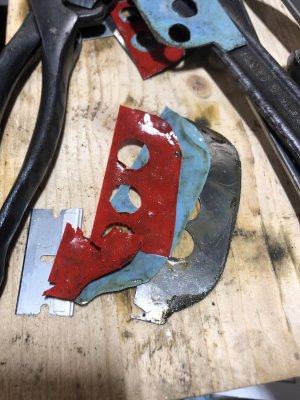I just finished going though the headstock. It disturbed me that that it wouldn’t run at top speed—that’s either an oiling problem or a bearing adjustment problem. I just couldn’t put that off.
These were the shims in the front bearing:

They added up to 0.018, and similar shims in the rear but thicker. The blue and red stuff is intentional but appears to be plastic and thin. At first I thought the shim was painted and that’s what had peeled off. The rear bearing shims were similar but thicker at 0.027.
I ordered a set of brass shims. Even though I have shim stock and punches, I hate making shims

Before pulling the caps, I measured deflection using a test bar as described by South Bend. An approximate 75-pound lift at 12” from the spindle is supposed to raise it 0.0007 to 0.0015. Mine was 0.0002. Oops! And the felt in the expander was missing, which I could see from the top. I ended up with a 0.021 stack, and that got me a deflection of 0.0012.
The rear bearing was flapping in the breeze by comparison, with 0.008 of deflection when lifted by the test bar. I ended up with the same 0.021 shim thickness as the front, and the deflection is still a bit over tolerance.
Once I had that figured out, I pulled the spindle to clean out the oil reservoir and install new wicks and felts. Getting it back together took several tries—something was binding on the rear bearing and I had to take it apart several times.
I can’t say I’m completely ecstatic about the result. I now have high speed, which I
am excited about. But the bearings have a lot of stiction and the belt wants to slip rather than starting when in high speed, unless I give it a little help. I don’t like having to help it start, but once it does, it will run indefinitely and not get even warm. I’ll live with it. Of course, I’m using Mobil Velocite No. 10, which is the specified spindle lubricant.
And because I had the end gear cover off, I cleaned the end gears up to the gearbox.
Next task: Apron. I have to get deep enough to extract the idler cam so I can repair it, and that’s all the way, so I might as well overhaul the apron completely.
Rick “this week” Denney


